Anti-French Druze Uprising in Syria 1925-27
Having decided to play the German party, the Turks found themselves faced with the necessity of waging war in four theaters of military operations: in the Caucasus, in the Balkans, in Mesopotamia and in Palestine. In addition, the Allies' persistent attempts to break through the Dardanelles to Istanbul had to be repelled. In the 1916 year, using the well-established agent, by the modest efforts of Sir Lawrence (who would later become Arabian), the British managed to raise a large-scale rebellion among Arab tribes in the Arabian Peninsula. Arabia, which was the outskirts of the empire, was controlled almost nominally by Istanbul: garrisons were in large cities, keeping order. Administrative power in many respects belonged to a conglomerate of local princes, sheikhs. The British, from the time of Chingachgook, who knew a lot about working with the local population, were here like fish in water.
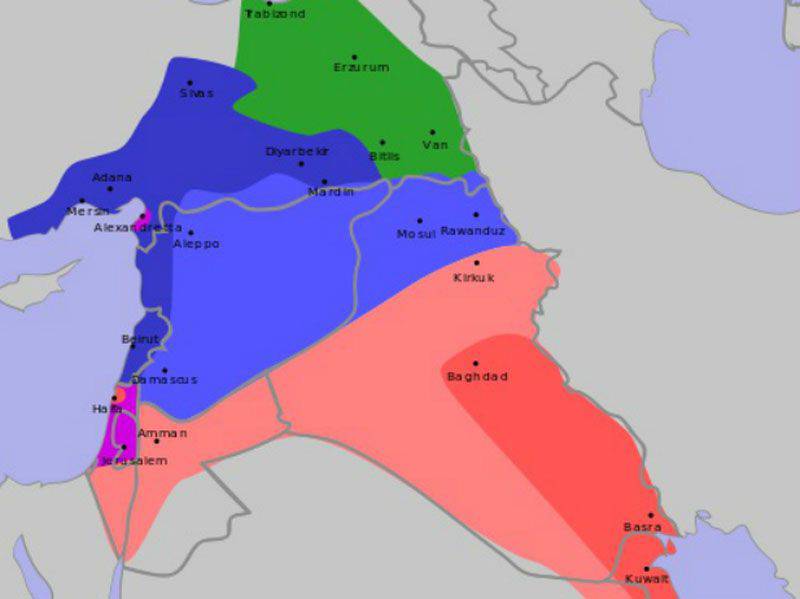
Enlightened mariners and their allies in the Entente had their own views on the post-war settlement of the Middle East. Sending a decrepit old man in the face of the Ottoman Empire in textbooks stories it was decided to speed up and consolidate the decision documented. In 1916, a secret agreement was reached between the governments of Russia, France and England, known as the Sykes-Picot Agreement, about the division of Turkish lands after the war. By agreement, England was to receive the modern territories of Iraq and Jordan and the area of the city of Haifa. France - southeastern Turkey, Syria, northern Iraq and Lebanon. Russia departed Constantinople with the Bosphorus and Dardanelles, southwestern Armenia and part of northern Kurdistan. The agreement did not provide for (oh, how distracted!) The fulfillment of the promise of creating an independent Arab state on the territory of so-called Great Syria, given by Sir Lawrence to Arabian Arabs. It was this promise that was the key argument that incited them to oppose the Ottoman Empire. This annoying forgetfulness, no doubt, of noble gentlemen, was the first, but by no means the last, batch of yeast thrown into the sun-warmed oil burning and age-old contradictions of the Middle Eastern boiler.
The legacy of a fallen empire
The Ottoman Empire fell, she could not with the industrial strongmen. The winners started the most pleasant procedure - the division of inheritance. In 1919, the former territories of the Ottoman Empire in the Middle East were occupied by the troops of England and France. It turned out that the population of Syria was not at all enthusiastic about the French garrisons stationed in the country, composed mainly of soldiers of the colonial troops. In a number of places rebellions broke out. It became obvious that some of the owners of the country were replaced by others, even more alien. The leaders of the local tribes tended to be elected king of Great Syria, Sheikh Faisal, who during the First World War commanded Arab troops as part of the British Expeditionary Force. In July, the Parliament of Great Syria refused to recognize the rights of France to any territory. Prince Faisal, who was a major figure in Middle Eastern affairs, had access to high European offices. Well aware of the direction of the undercurrents in the capitals of the Entente and not wanting to quarrel in a large way, he decides to reach a compromise solution to the Syrian issue. 6 January 1920, he signs an agreement with French Prime Minister Clemenceau, which recognized the Syrians' right to independence and the creation of their own state. In fact, it was already nothing meaningful agreement. Already 8 March 1920, the Syrian National Congress in Damascus rejects this agreement and proclaims Syria an independent state, which includes not only Syria, Lebanon, Palestine, but also part of northern Mesopotamia, which, according to the Sykes-Picot agreement, were included in the zone of the British interests. Prince Faisal was declared the head of state.
Seeing that the process in the Middle East could get out of control, the allies (or already accomplices) in a pretty stuck in the internal contradictions of the Entente quickly convene a conference held in the Italian town of San Remo from 19 to 26 on April 1920 of the year. It held the issuance of mandates, that is, the right to manage the former Turkish possessions in the Middle East, basically repeating the lines of demarcation of the Sykes-Picot agreement. Britain received a mandate for Palestine and Iraq, France - for Syria, along with modern Lebanon. With regard to the Arab state formations, an ambiguous promise was made to recognize the conditional independence of Syria and Iraq, in order to declare this very independence when they themselves can become independent states. In fact, this meant: "We will steer until you get bored."
Obviously, for European politicians, the entire native population on different continents was the same person. Neither the problems of the region, its complex national-ethnic and religious composition, nor the deep historical traditions were taken into account. Those who cut the world map with the help of a ruler and a compass, did not care that they divided not the paper, but the lives and destinies of entire nations.
No independence
The French, who were becoming more and more like invaders, were, to put it mildly, not happy. At the end of 1919 of the year, realizing what was going on, at the initiative of various parties, the People’s Council of National Defense was created. In different regions of the country, under his auspices, armed groups were formed. To counteract the possible actions of the French 3 in May 1920, a national defense government was formed in Damascus headed by the chairman of the General Syrian Congress, Hashim al-Atassi, who became prime minister. Having received Syria, France, represented by General Gouraud, sent a de facto ultimatum to the government of Faisal - Al-Atassi, demanding to disband the armed forces and recognize the results of the conference in San Remo. In May and July, a series of military clashes occurred in which the French dispersed the insurgent units thanks to organizational and military superiority. Faisal, who presented himself as a compromise figure and did not want to get seriously involved with the Entente, July 21, 1920, recognized the French mandate to govern Syria. A large role in making this decision was played by representatives of local nobility and large landowners who do not want to suffer losses as a result of the war. Defense Minister Yusuf al-Azma did not recognize the king’s surrender and, together with three thousand soldiers, tried to continue the fight. Poorly trained and armed rebels were defeated by the French near the city of Maysaloun, and the former minister himself was killed in battle. This battle for the Syrians became a symbol of the struggle against colonial rule. 24 July 1920, the French army entered Damascus. The next day, the Arab kingdom was liquidated. King Faisal from sin away left the country, after serving in the English possession in Mesopotamia. French General Henri Gouretau began to form the colonial administrative system of power. The Syrians made it clear that independence does not shine.
Return of the crusaders
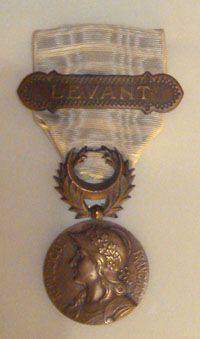
Guro was an old colonial warrior with experience. He had military operations in Chad, Mali, Morocco and Mauritania. He had no particular illusions about the Syrians, and believed that only tough methods could strengthen French control over Syria. Looking around the tomb of the legendary Salah ad-Din in the al-Ayubi mosque, the general said: "We did return, Salah ad-Din." France climbed into the Middle East cheekily and brazenly, without local features. The Ottoman Empire, which owned these lands for a long time, was in many ways a more skilled and flexible administrator than the ambitious Europeans who replaced it. The thinking of the colonial categories firmly entrenched in the cabinets of ministers and the military, firmly and sincerely convinced that only a white man (and even with restrictions) is capable of independent state-building. The rest indulgently appointed servants.
Strengthening themselves in place, the French demanded that the local Syrian authorities fulfill several conditions: compensation of 10 million francs, the disarmament of the similarity of the army that the Syrians had, and at the same time the local population. The new government of Al-Al-Din al-Drubi has fulfilled all these requirements. However, several peripheral sheikhs in the province of Hauran flatly refused to participate in the payment of any compensation and indemnities. The Prime Minister, together with a delegation that included the French, went to negotiate in a special train in August 1920. Upon arrival at the terminal station in the province of Hauran, the train was stormed by the locals, all who were in it were killed, including Prime Minister Al ad-Din al-Drubi and several French. In response, the administration of General Guro undertook a punitive expedition with the support of aviation. The toughest measures were applied to the civilian population: several villages were burned, crops were damaged (Hauran was the breadbasket of Syria at that time). Instead of Al ad-Din al-Drubi, the French appointed the head of the Syrian government a much more submissive Hakka al-Azma. His post was no longer called the prime minister, but the governor of Damascus, to remind the Syrians once again: you should not even think about any government. The French divided the country into several territories: Damascus, Aleppo, Greater Lebanon and Jebel Druz. They pursued a short-sighted policy, enforcing the local administration of French officials, who immediately began to climb into the internal affairs of the tribes, not knowing any customs or traditions. The results began to affect quickly enough.
Following the unrest in Hauran, the north flared up. Here, the struggle against the French was led by a talented commander and organizer, who came from a noble family, Ibrahim Henan. After studying in Istanbul, after the war he returned to Syria, was elected to the National Congress. Not having accepted the capitulatory policy of Faisal, he went home to the northern province of Aleppo, where he soon organized a large armed detachment. The number of supporters of Henanu began to grow, as did the territory controlled by him. A total of over 30 thousand French troops were sent against his troops. In the end, in June 1921, with great effort, they managed to suppress performances in Aleppo. Ibrahim Henanu himself was able to hide, having made his way into the territory controlled by the British. At the request of the French authorities, he was handed over to them and put on trial. However, the popularity of Henan was so great that he had to give up and let go of the tempting idea to condemn him. Until his death in 1935, Ibrahim Henan was one of the main leaders of the national liberation movement.
Syria began to cost the French, if not too expensive, then expensive. The third High Commissioner in Syria, General Weygun, in July 1924, during a speech given in Beirut at the memory of the dead French soldiers, called the number in 9 thousand soldiers killed and 250 officers - that was how much French control over Syria was for that period. But the biggest uprising was still to come.
Insurrection
22 December 1924, a new commissioner, General Maurice Sarray, famous for his liberal views, arrived in Beirut. In contrast to the predecessors, who believed that local business should be done with the help of a carrot and a carrot, and with a predominance of the first, Sarray decided to try to ease the tension and reduce the pressure in the boiler. He abolished the state of emergency declared from the very beginning of the occupation, freed a number of political prisoners, expressed a desire to elect any of the local governors of Lebanon. Sarray expressed his willingness to listen to local and allowed political parties, which was previously prohibited. 17 January 1925, a delegation gathered in Damascus, met with the Commissioner and presented him with a number of demands, the essence of which was to restore Syria to the natural borders within which it existed before World War I, that is, to the size of the recent Syrian kingdom, to convene a Constituent Assembly for the creation of a constitution, the abolition of the military command system, the abolition of foreign tribunals and the introduction of a single court procedure.
Sarrai, realizing what the direct fulfillment of all Syrian demands could lead to, immediately lowered the level of liberalism, escaping with general assurances of the kind "I understood you." However, permission to create a party was given, and soon it was created. The first political party called Al-Shaab (People) since the beginning of the French occupation was created at the beginning of 1925. It was headed by a doctor by profession, Abd ar-Rahman al-Shahbender.
The lid on the boiler was raised, but it was already too hot. A new outbreak of flame finally brought it to a boil. The name of this flash is druze.
Druze factor
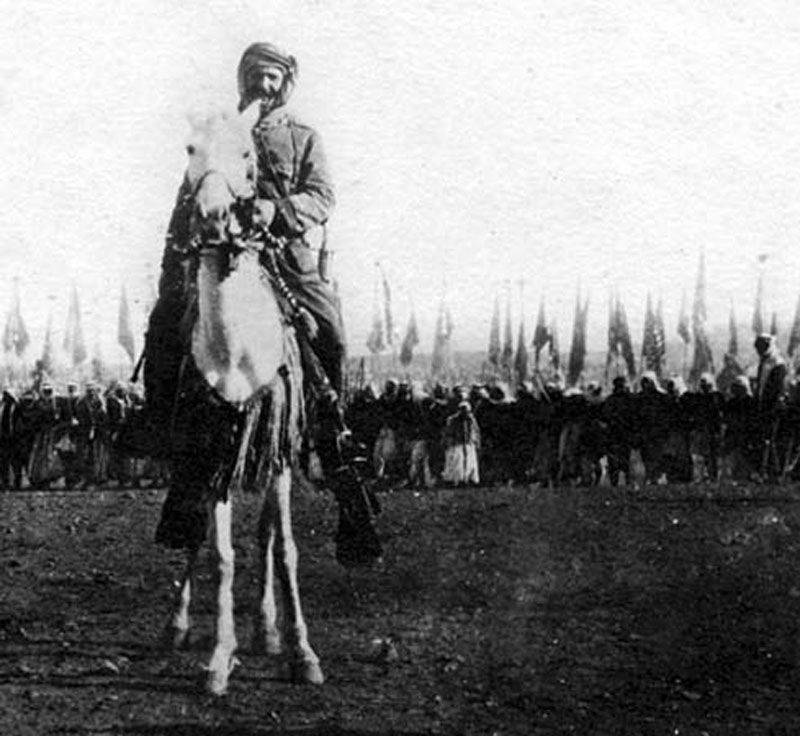
The religious community of Druze was a very closed community. Druzes inhabited the southern and southeastern regions of the country. Their place of residence was allocated to the French in a separate administrative region, hypocritically called the "state of Jebel-Druz". There was even created some kind of government governed by a French officer. Local administrative bodies were also headed by the French. However, they did not enjoy indisputable authority, but the influential and large family of Banu al-Atrash, in whose hands the true, not the protocol, power was concentrated. Independent and freedom-loving Druzes had difficulty tolerating aliens with their merciless policies, until the excessively cruel French officer, Captain Carbillier, who led the so-called "government", did not go out of the box at all. Appointed for the post in 1925, he immediately began the persecution of the al-Atrash family, tightened tax collection, and began to forcefully disarm the population. When Carbiye, tired of the “white man's burden”, finally went on vacation to France and received information that a new commissar Sarrai, wagging the olive branch of the world, arrived in Syria, the Druze decided to send a delegation to him. Their leader, Sultan al-Atrash, through his envoys, tried to gain respect for sovereignty and appointment instead of Karbiye as head of the “government” of the Druze. The Commissioner, who had by this time exhausted the lion's share of his liberalism, did not accept them very kindly and rudely refused to the friends in their requests. The second delegation was simply not allowed to enter the residence. Now it has become clear even to the moderate leaders of the community that the French are not the ones with whom you can agree on something. Druze leaders were inclined to resolve the issue. Realizing that the performance by the forces of their community alone did not achieve the desired results, they met with the leader of the Al-Shaaab party, Rahman al-Shahbender, at which they agreed in principle to support the performance of Druze in Damascus and in other parts of the country. The gathering - Druze and party members - vowed to protect their homeland to the last drop of blood.
Epicenter of the uprising
The starting point of the uprising was the battle near the village of Al-Kafra on July 16, 1925 in the territory of Jebel Druz, which became the main focus. A French battalion of 200 soldiers was sent to Al-Qarya, the residence of the Druze leader Sultan al-Atrash, to detain him. In the ensuing battle, the French were driven back to Al-Kafra and completely destroyed. After that, the Druze advanced to the city of Sueide, the main stronghold of the occupation authorities and besieged its garrison. Upon learning of the uprising, Sarray decided to act in the traditional way of force: a special detachment of General Mishu was formed, whose task was to unload the Sueida. August 1 reinforced by artillery and tanks Renault FT, accompanied by a large convoy, a French expedition of more than 3 thousand people advanced to Swayde. Misha and his officers were confident of success, counting on their technical and fire superiority. But they underestimated the enemy. Like the Arabian horse archers of the Middle Ages, the Druze cavalry circled the French marching column, as their ancestors once pursued the clumsy armies of the crusaders. History repeated itself, and perhaps in vain General Guro clever at the grave of the legendary Salah ad-Din. On the night of August 2–3, having suddenly attacked the enemy’s rearguard, the rebels managed to capture and partially destroy the enemy convoy, including fuel for equipment and water supplies. The column was disorganized and camped near the village of Al Mazraa, where it was attacked by large forces of the Druze in the late evening of August 3. Soon the French began to lack ammunition, the slow Renaults were useless against the swift action of the cavalry - the rebels jumped onto the hull, pulled out the crew and destroyed it. Thus, 5 tanks were destroyed. Mishu’s detachment was defeated and retreated in disarray, leaving behind virtually all of the heavy weapons: machine guns and artillery. It was already a major success. Arriving at a meeting with Sultan al-Atrash on August 25, Shahbender agreed with the Druze leader on the full coordination of further actions. A general rebellion against the French occupation in Syria was announced.
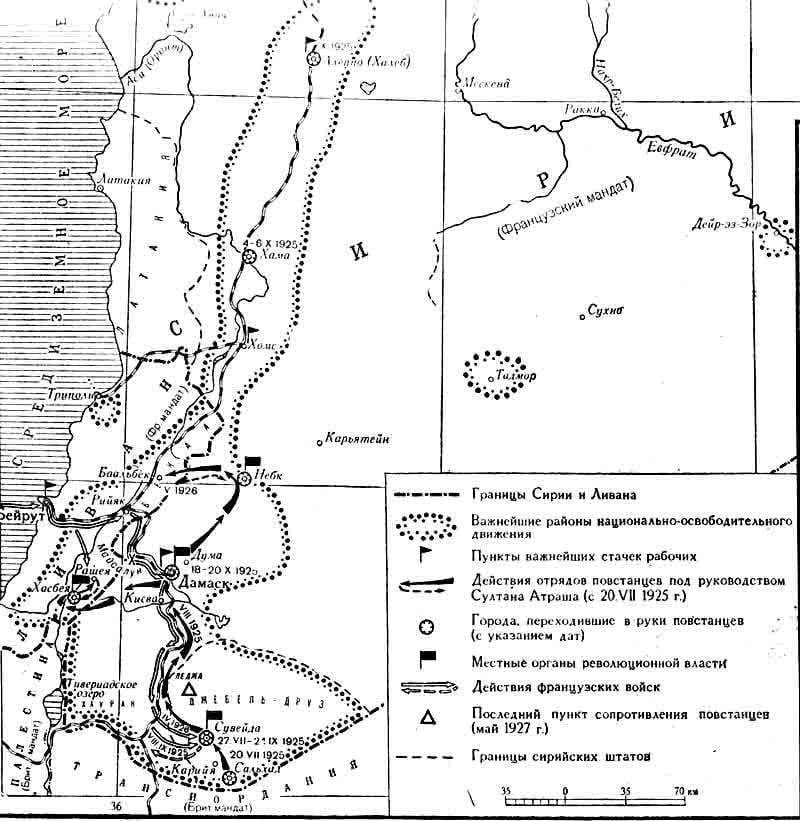
Soon the flames of speeches covered not only the area of Jebel Druz, but also other regions. The suburb of Damascus Guta has risen. The rebels, quickly crushing the colonial police, broke through to the center of the city, where the palace of Qasr al-Azm, the residence of the high commissioner, was located. Realizing the seriousness of the situation, Sarrai left Damascus under heavy guard. On the streets of the city, especially in its southern part, persistent battles continued. The entire French population of Damascus was concentrated in the Al-Salihiya government district, which was reinforced with barricades reinforced with machine gun points and tanks. The numerical superiority of the rebels remained confidently. Realizing that the city could not be held, on October 18, the French command opened massive artillery fire on the rebel-controlled neighborhoods on October 1925. Aviation soon joined the strikes against the rebels. Under this fire cover, the French withdrew their troops and the European population from Damascus. The bombardment caused great damage to the city: many buildings, including historic ones, were damaged. The palace-residence of Qasr al-Azm, which is part-time and a museum, was almost completely destroyed and looted. Converted into ruins and other historic buildings - palaces and mosques.
Flame
The news of the destruction of one of the oldest cities in the Middle East shook the public, even in France. The French government was forced to recall General Sarray, 8 on November 1925, he left Beirut. His place was taken by General de Jouvinel. For the destruction of Damascus, Sarrai did not suffer any punishment - he was simply offered to retire.
While street fighting continued in Damascus, the colonial authorities decided to change the situation in the area still blocked by Swayda. 13 September 1925 arrived on board a warship in Beirut, General Gamelin (who will lead the French army at the beginning of World War II in the future). He received an order to march to Suade and lift the siege - the garrison already lacked the means of supply. 23 September 1925, Gamelin, at the head of a large squad, began to move. At first, he advanced unhindered - the rebels wanted to lure the enemy deeper into mountainous terrain. 24 September he approached Swayide and unlocked it. As it turned out later, the Druze specifically allowed Gameleen to the besieged city. With the onset of darkness, the rebels attacked the French forces, using captured mortars and artillery. Remembering the sad fate of the previous expedition of General Misha and believing that this was the beginning of a big attack, Gamelin decided to withdraw his troops to the plain terrain to the village of Al-Musafera, where, he thought, it was more convenient to keep the defense. The French were so kind that they once again left the rebels in Swayide a lot of heavy weapons, equipment, broken trucks. Maybe the syndrome of the Great Army, retreating from Moscow, along with a huge wagon train that slowed down its advancement, has operated to this day. Having built a fortified camp, Gamelin was in a semi-encircled position. The supply of his group was limited and carried out by convoys, some of which did not reach the destination.
October 4 The 1925 began an uprising in the large city of Hama. The rebels, capturing the gendarmerie barracks, gained access to armswhich immediately used. Violent battles took place in the area of the army barracks, which could not be seized. After receiving reinforcements, the French garrison managed to retain control over the city center. Suppression of the performance in Hama dragged on until October October 14. Colonial troops used artillery extensively, leveling whole neighborhoods without worrying about preserving historical values, not to mention “democratic” —for example, such as human life.
Taking advantage of the fact that the group of General Gamelin was actually blocked and neutralized, the supreme leadership of the rebels decided to expand the area of the uprising by undertaking a raid on the vast lands between Damascus and Al-ku-Neitra inhabited by the Druze. At the end of October, 1925, a large rebel detachment under the command of Zeid al-Atrash, younger brother of the rebellion leader Sultan al-Atrash, was sent to this region and successfully occupied a number of settlements, the largest of which was Hasbayya. After these successes, the further efforts of the rebels switched to mastering the strategic village of Riak - this would make it possible to cut off the communication of the French between Damascus and Beirut. The Raiak garrison, supplied with large reserves, took up positions in the old fortress. Rejecting the idea of besieging the enemy, 22 November 1925, the Syrians attacked the fortress from three sides and, after a long and bitter battle, captured it. Losses, lack of armaments and domestic political reasons stopped the further advance of the rebels.
Decoupling
Time worked for the French. While the Syrians were gathering their forces and arguing about the future path of development of the uprising, more and more new units arrived in Syria. First of all, the colonial troops from Senegal, Algeria and Morocco. A few words must be said about the Circassian troops, who played a large role in suppressing the uprising. The ancestors of the Circassians moved to Syria from the Caucasus in the XIX century. Their fighting qualities were appreciated by the French, despite the fact that the first three Circassian squadrons, formed in 1925, belonged to the Levant Army (native troops), and not to the Eastern Army (actually French units). Two squadrons are being built in 1926, and three more in 1927. These cavalry units were consolidated in the Levant Light Squadron Regiment under the command of Captain (later Brigadier General) Philibert Kolle. It was a very good tool against the cavalry units of the Druze. The regiment received a resounding motto: "For the honor of giving life."
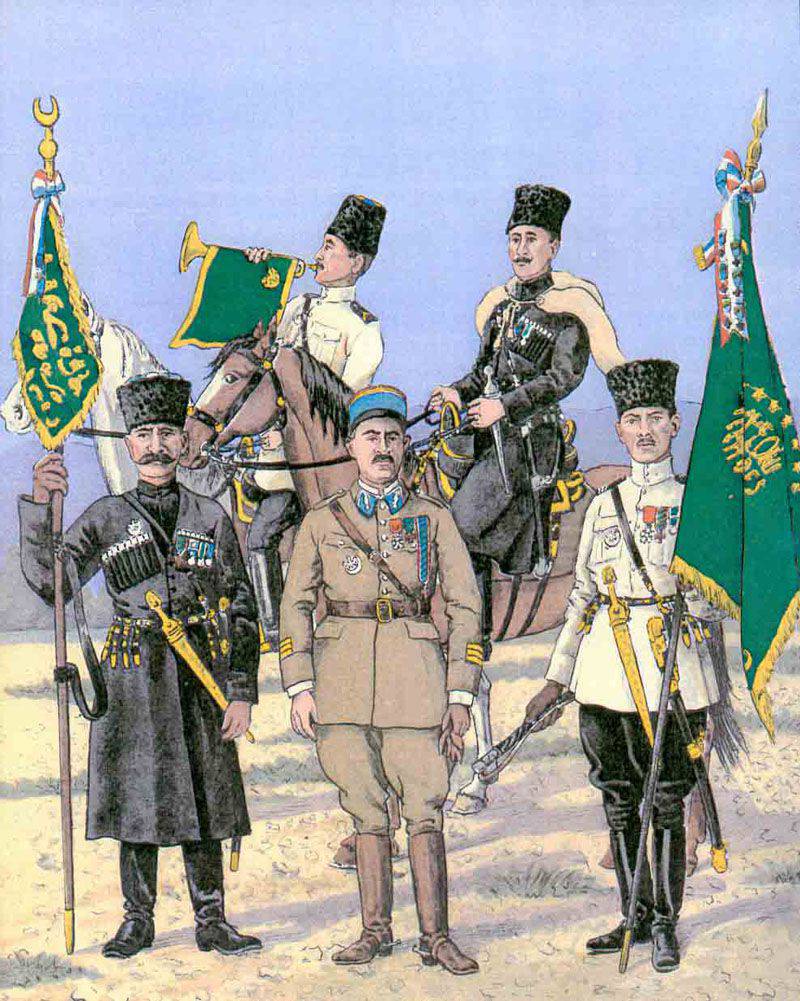
Since the summer of 1926, the French army, whose strength has been brought to almost 100 thousand, has launched an offensive against isolated rebel forces. Tanks and aircraft were actively used. Damascus and other cities were reoccupied. The internal disunity of the rebels, their lack of organization and difference in goals (residents of one region did not want to fight in another) led them to defeat. Sultan al-Atrash fled to Arabia.
Such a major uprising, which also broke out in parallel with the war in Morocco, puzzled the French authorities. A number of decisions were made to reduce tensions among the local population, and the policy of its loyalty was expanded. The French refused to divide the country into regions. 9 June 1928 of the year were held elections to the Constituent Assembly, which won the patriotic forces. In 1932, Syria was proclaimed a republic with the preservation of the French mandate, which was canceled only in 1943.
The Syrian uprising, or the uprising of the Druze, entered the colonial history of France as one of the largest speeches against colonial rule. Attempts to play in the new Crusaders led only to the next wave of opposition. In 1920, French Prime Minister Georges Leahs rashly declared: "We have come to Syria forever." The East was and remained too complicated a ball, for which the simple solutions were not always suitable. At the cost of great efforts, Paris managed to retain a segment of its colonial empire, but only so that in just some 20 years its rapid collapse began.
Information